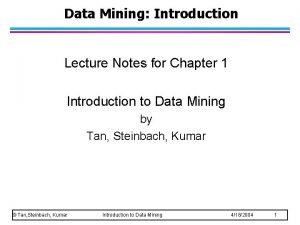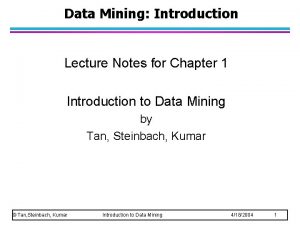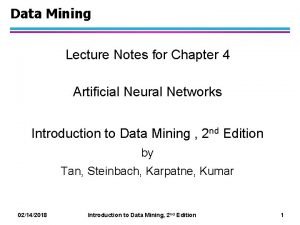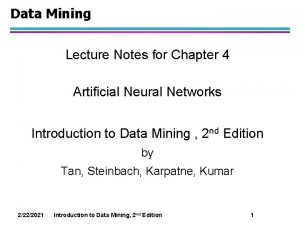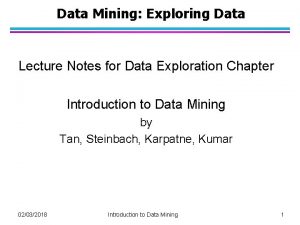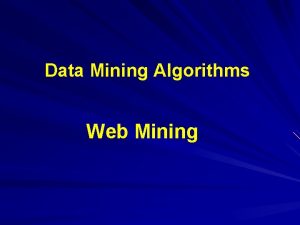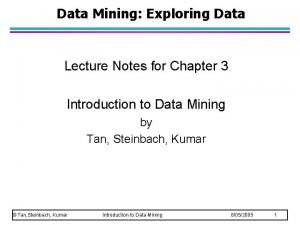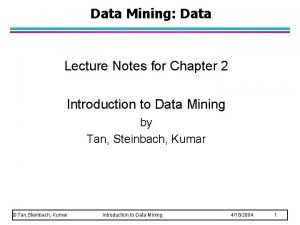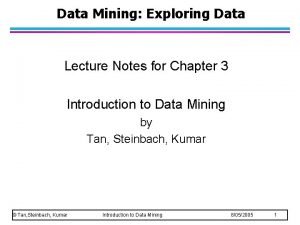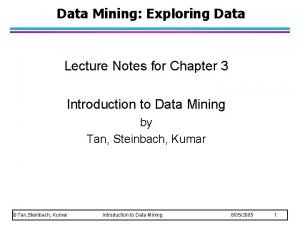Data Mining Lecture Notes for Chapter 4 Artificial
























- Slides: 24

Data Mining Lecture Notes for Chapter 4 Artificial Neural Networks Introduction to Data Mining , 2 nd Edition by Tan, Steinbach, Karpatne, Kumar 10/15/2019 Introduction to Data Mining, 2 nd Edition 1

Artificial Neural Networks (ANN) Output Y is 1 if at least two of the three inputs are equal to 1. 10/15/2019 Introduction to Data Mining, 2 nd Edition 2

Artificial Neural Networks (ANN) 10/15/2019 Introduction to Data Mining, 2 nd Edition 3

Artificial Neural Networks (ANN) l Model is an assembly of inter-connected nodes and weighted links l Output node sums up each of its input value according to the weights of its links Perceptron Model l Compare output node against some threshold t 10/15/2019 Introduction to Data Mining, 2 nd Edition 4

General Structure of ANN Training ANN means learning the weights of the neurons 10/15/2019 Introduction to Data Mining, 2 nd Edition 5

Artificial Neural Networks (ANN) l Various types of neural network topology – single-layered network (perceptron) versus multi-layered network – Feed-forward versus recurrent network l Various types of activation functions (f) 10/15/2019 Introduction to Data Mining, 2 nd Edition 6

Perceptron l Single layer network – Contains only input and output nodes l Activation function: f = sign(w x) l Applying model is straightforward – X 1 = 1, X 2 = 0, X 3 =1 => y = sign(0. 2) = 1 10/15/2019 Introduction to Data Mining, 2 nd Edition 7

Perceptron Learning Rule Initialize the weights (w 0, w 1, …, wd) l Repeat – For each training example (xi, yi) l Compute f(w, xi) u Update the weights: u l Until stopping condition is met 10/15/2019 Introduction to Data Mining, 2 nd Edition 8

Perceptron Learning Rule l Weight update formula: l Intuition: – Update weight based on error: – If y=f(x, w), e=0: no update needed – If y>f(x, w), e=2: weight must be increased so that f(x, w) will increase – If y<f(x, w), e=-2: weight must be decreased so that f(x, w) will decrease 10/15/2019 Introduction to Data Mining, 2 nd Edition 9

Example of Perceptron Learning 10/15/2019 Introduction to Data Mining, 2 nd Edition 10

Perceptron Learning Rule l Since f(w, x) is a linear combination of input variables, decision boundary is linear l For nonlinearly separable problems, perceptron learning algorithm will fail because no linear hyperplane can separate the data perfectly 10/15/2019 Introduction to Data Mining, 2 nd Edition 11

Nonlinearly Separable Data XOR Data 10/15/2019 Introduction to Data Mining, 2 nd Edition 12

Multilayer Neural Network l Hidden layers – intermediary layers between input & output layers l More general activation functions (sigmoid, linear, etc) 10/15/2019 Introduction to Data Mining, 2 nd Edition 13

Multi-layer Neural Network l Multi-layer neural network can solve any type of classification task involving nonlinear decision surfaces XOR Data 10/15/2019 Introduction to Data Mining, 2 nd Edition 14

Learning Multi-layer Neural Network l Can we apply perceptron learning rule to each node, including hidden nodes? – Perceptron learning rule computes error term e = y-f(w, x) and updates weights accordingly u Problem: how to determine the true value of y for hidden nodes? – Approximate error in hidden nodes by error in the output nodes u Problem: – Not clear how adjustment in the hidden nodes affect overall error – No guarantee of convergence to optimal solution 10/15/2019 Introduction to Data Mining, 2 nd Edition 15

Gradient Descent for Multilayer NN l Weight update: l Error function: l Activation function f must be differentiable l For sigmoid function: l Stochastic gradient descent (update the weight immediately) 10/15/2019 Introduction to Data Mining, 2 nd Edition 16

Gradient Descent for Multi. Layer NN l For output neurons, weight update formula is the same as before (gradient descent for perceptron) l For hidden neurons: 10/15/2019 Introduction to Data Mining, 2 nd Edition 17

Design Issues in ANN Number of nodes in input layer – One input node per binary/continuous attribute – k or log 2 k nodes for each categorical attribute with k values l Number of nodes in output layer – One output for binary class problem – k or log 2 k nodes for k-class problem l Number of nodes in hidden layer l Initial weights and biases l 10/15/2019 Introduction to Data Mining, 2 nd Edition 18

Characteristics of ANN l l l Multilayer ANN are universal approximators but could suffer from overfitting if the network is too large Gradient descent may converge to local minimum Model building can be very time consuming, but testing can be very fast Can handle redundant attributes because weights are automatically learnt Sensitive to noise in training data Difficult to handle missing attributes 10/15/2019 Introduction to Data Mining, 2 nd Edition 19

Recent Noteworthy Developments in ANN Use in deep learning and unsupervised feature learning – Seek to automatically learn a good representation of the input from unlabeled data l Google Brain project – Learned the concept of a ‘cat’ by looking at unlabeled pictures from You. Tube – One billion connection network l 10/15/2019 Introduction to Data Mining, 2 nd Edition 20

Deep Neural Networks l Involve a large number of hidden layers l Can represent features at multiple levels of abstraction l Often require fewer nodes per layer to achieve generalization performance similar to shallow networks l Deep networks have become the technique of choice for complex problems such as vision and language processing 10/15/2019 Introduction to Data Mining, 2 nd Edition 21

Deep Nets: Challenges and Solutions l Challenges – Slow convergence – Sensitivity to initial values of model parameters – The larger number of nodes makes deep networks susceptible to overfitting l Solutions – Large training data sets – Advances in computational power, e. g. , GPUs – Algorithmic advances New architectures and activation units u Better parameter and hyper-parameter selection u Regularization u 10/15/2019 Introduction to Data Mining, 2 nd Edition 22

Deep Learning Characteristics l Pre-training allow deep learning models to reuse previous learning. – The learned parameters of the original task are used as initial parameter choices for the target task – Particularly useful when the target application has a smaller number of labeled training instances than the one used for pretraining l Deep learning techniques for regularization help in reducing the model complexity – Lower model complexity promotes good generalization performance – The dropout method is one regularization approach – Regularization is especially important when we have high-dimensional data u a small number of training labels u the classification problem is inherently difficult. u 10/15/2019 Introduction to Data Mining, 2 nd Edition 23

Deep Learning Characteristics … l l l Using an autoencoder for pretraining can – Help eliminate irrelevant attributes – Reduce the impact of redundant attributes. Single-layer Autoencoder ANN models, especially deep models, can find inferior and locally optimal solutions, – Deep learning techniques have been proposed to ensure adequate learning of an ANN – Example: Skip connections Specialized ANN architectures have been designed to handle various data sets. – Convolutional Neural Networks} (CNN) handle two-dimensional gridded data and are used for image processing – Recurrent Neural Network handles sequences and are used to process speech and language 10/15/2019 Introduction to Data Mining, 2 nd Edition 24
 Bayesian classification in data mining lecture notes
Bayesian classification in data mining lecture notes Data mining lecture notes
Data mining lecture notes Data mining lecture notes
Data mining lecture notes Data mining lecture notes
Data mining lecture notes Mining complex data types
Mining complex data types 01:640:244 lecture notes - lecture 15: plat, idah, farad
01:640:244 lecture notes - lecture 15: plat, idah, farad Artificial neural network in data mining
Artificial neural network in data mining Multimedia data mining
Multimedia data mining Exploratory data analysis lecture notes
Exploratory data analysis lecture notes Strip mining vs open pit mining
Strip mining vs open pit mining Strip mining vs open pit mining
Strip mining vs open pit mining Difference between strip mining and open pit mining
Difference between strip mining and open pit mining Text and web mining
Text and web mining Data reduction in data mining
Data reduction in data mining What is data mining and data warehousing
What is data mining and data warehousing What is missing data in data mining
What is missing data in data mining Concept hierarchy generation for nominal data
Concept hierarchy generation for nominal data Data reduction in data mining
Data reduction in data mining Data reduction in data mining
Data reduction in data mining Shell cube in data mining
Shell cube in data mining Data reduction in data mining
Data reduction in data mining Perbedaan data warehouse dan data mining
Perbedaan data warehouse dan data mining Data mining dan data warehouse
Data mining dan data warehouse Data warehousing and data mining in crm
Data warehousing and data mining in crm Multidimensional analysis and descriptive mining of complex
Multidimensional analysis and descriptive mining of complex


